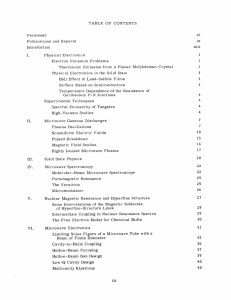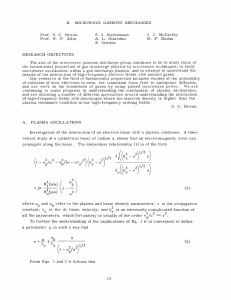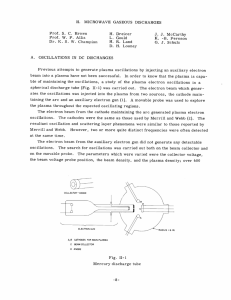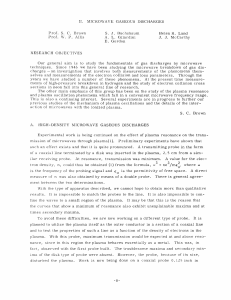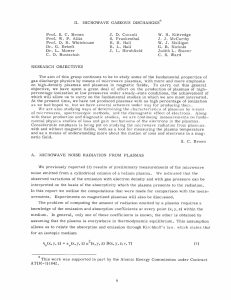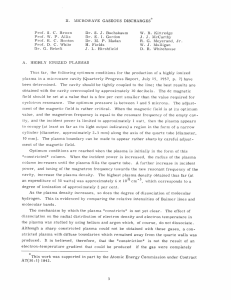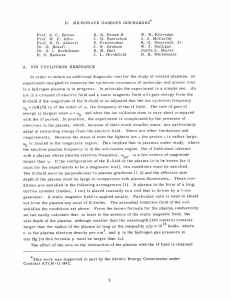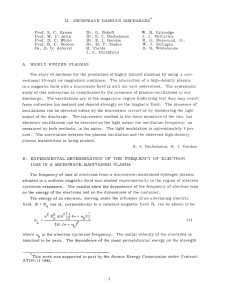Prof. S. C. Brown
advertisement
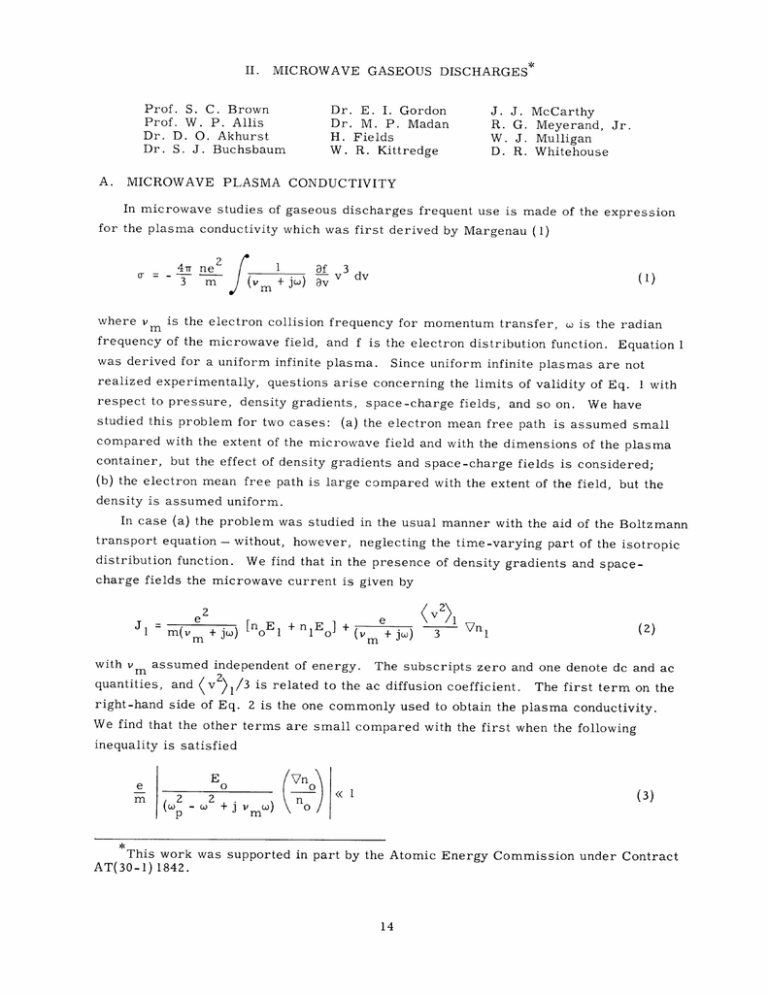
II. MICROWAVE GASEOUS DISCHARGES* Prof. S. C. Brown Prof. W. P. Allis Dr. D. O. Akhurst Dr. S. J. Buchsbaum A. Dr. E. I. Gordon Dr. M. P. Madan H. Fields W. R. Kittredge J. R. W. D. J. G. J. R. McCarthy Meyerand, Jr. Mulligan Whitehouse MICROWAVE PLASMA CONDUCTIVITY In microwave studies of gaseous discharges frequent use is made of the expression for the plasma conductivity which was first derived by Margenau (1) 4rr ne 1 m S3 Vm + jo ) af v v 3 dv (1) where vm is the electron collision frequency for momentum transfer, c is the radian frequency of the microwave field, and f is the electron distribution function. Equation 1 was derived for a uniform infinite plasma. Since uniform infinite plasmas are not realized experimentally, questions arise concerning the limits of validity of Eq. 1 with respect to pressure, density gradients, space-charge fields, and so on. We have studied this problem for two cases: (a) the electron mean free path is assumed small compared with the extent of the microwave field and with the dimensions of the plasma container, but the effect of density gradients and space-charge fields is considered; (b) the electron mean free path is large compared with the extent of the field, but the density is assumed uniform. In case (a) the problem was studied in the usual manner with the aid of the Boltzmann transport equation - without, however, neglecting the time-varying part of the isotropic distribution function. We find that in the presence of density gradients and spacecharge fields the microwave current is given by e2 = 1 m(v m + j) e+ (V21 [nE + nlE ] + * _ 2 Vn oE1 lE] (vm + j) 3 (2) (2) with vm assumed independent of energy. The subscripts zero and one denote dc and ac quantities, and ( v 2)1/3 is related to the ac diffusion coefficient. The first term on the right-hand side of Eq. 2 is the one commonly used to obtain the plasma conductivity. We find that the other terms are small compared with the first when the following inequality is satisfied E e m 2 p 2 Vn o j VW)n m 0) (3) This work was supported in part by the Atomic Energy Commission under Contract AT(30-1) 1842. (II. where wo is the plasma frequency. MICROWAVE GASEOUS DISCHARGES) For microwave plasmas under conditions of ambi- polar diffusion Eq. 3 reduces to Vn v2 3K - 0 ( 3 2 +j v 2 1 1 W) (n (4) Kv2 /3 is related to the dc diffusion coefficient. where When w < o, Eq. 4 yields the condition Vn n OD < (5) where f D is the Debye length. p > w. When w The condition given by Eq. 5 is less stringent when wp , inequality 4 yields a lower limit on pressure below which Eq. 1 may be incorrect. For de plasmas, when w = wp the inequality to be satisfied is vd Vn - W n (6) << 1 o Inequality 6 states that the distance drifted in where vd is the electron drift velocity. one period of the ac field must be small compared with (n /Vno). In case (b), wherein the mean free path is large compared with the extent of the field, the usual method of expanding the distribution function in spherical harmonics in velocity and in Fourier series in time, and terminating each expansion after the first two terms, is not adequate. A more fruitful approach is to consider the motion of the individual plasma electrons by using small-signal analysis and averaging over the velocity distribution function. If a uniform ac field E 1 is maintained between the planes z = 0 and z = d in a uniform plasma, we find that the average conductivity of the gap is given by 4r ne 3 m v 3 jf v vm + jW - d 4d(j 1 + Vm dv In obtaining Eq. 7, terms of the order exp(-3w2d2 /vZ)) with unity. 1/ 4 (v/dw) were neglected compared This limits the validity of Eq. 7 to those cases in which the average elec- tron spends more than three cycles of the ac field in the gap. 2 (7) ) When (vm/) are small compared with unity, Eq. 7 is analogous to Eq. 2 and 1 if an effective col- lision frequency v'm is defined as v' m = v m + 3 v 4d (8) (II. MICROWAVE GASEOUS DISCHARGES) Equation 8 indicates that, when the extent of the ac field is small compared with the mean free path, the width of the gap defines, an effective mean free path. gap obliquely. as far as the microwave field is concerned, The factor 4/3 comes in because the electrons enter the We also find that the smallness of the gap does not alter the energy- storing ability of the plasma electrons. S. J. Buchsbaum, E. I. Gordon References 1. H. Margenau, B. Phys. Rev. 69, 508 (1946). HIGHLY IONIZED PLASMAS In a further attempt to produce a highly ionized microwave plasma in hydrogen a microwave system similar to that described previously (1) but capable of supplying cw power of 1000 watts was assembled. It was necessary to construct a variable attenua- tor capable of dissipating 1000 watts with negligible insertion loss. It was possible to use a probe for coupling into the microwave cavity by surrounding the probe with a Teflon shield. The cavity was designed to resonate in the TE111 mode at S-band, and in the TE011 and TM i l l modes at C-band. The last two modes are utilized to measure the electron density. Preliminary attempts have yielded degrees of ionization of approximately 0. 5 per cent at a pressure of 10 - 3 mm Hg. E. I. Gordon, S. J. Buchsbaum References 1. Quarterly Progress Report, Research Laboratory of Electronics, 1957, p. 17. C. HIGH-CURRENT M.I.T., Jan. 15, PROTON SOURCE Construction was completed and initial testing has begun on a high-current proton source. -3 The source employs hydrogen gas at a pressure of 10-3 mm Hg that is ionized by the action of 100-mec rf power. The protons are extracted from the ionized hydrogen and focused into a beam by electrodes whose shape was determined by considering the space-charge field of the proton beam. The focusing was satisfactory. A magnetic field which is applied parallel to the axis of the beam serves three purposes. First, it helps contain the beam. Second, it reduces electron loss in the ionized gas region, which results in a higher plasma density and consequently gives a higher proton density. Third, as the ionizing electric field is applied perpendicular to the magnetic field, it provides an efficient means of transferring energy to the electrons (II. MICROWAVE GASEOUS DISCHARGES) by cyclotron resonance. An attempt will be made to correlate the effect of gas pressure, age, accelerating volt- rf power, and magnetic field upon beam current. R. G. Meyerand, Jr.




